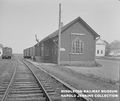Dominion Atlantic Railway Digital Preservation Initiative - Wiki
Use of this site is subject to our Terms & Conditions.
Difference between revisions of "Canning"
Dan Conlin (talk | contribs) m |
Dan Conlin (talk | contribs) |
||
| Line 35: | Line 35: | ||
*Mrs. Wm. Sangster/R.W. DeWolfe Company Warehouse, 10,000 barrel capacity, Mile 9.9 | *Mrs. Wm. Sangster/R.W. DeWolfe Company Warehouse, 10,000 barrel capacity, Mile 9.9 | ||
*[[Canning Wye and Spur]]: 3300' spur to Canning wharf, active circa 1911-1920, mainly for Borden private railway car South leg: c. Mile 9.8, North leg: c. Mile 10.1 | *[[Canning Wye and Spur]]: 3300' spur to Canning wharf, active circa 1911-1920, mainly for Borden private railway car South leg: c. Mile 9.8, North leg: c. Mile 10.1 | ||
| − | *[[Habitant River Bridge]], Mile 9. | + | *[[Habitant River Bridge]], Mile 9.6 |
==Operations & Orders== | ==Operations & Orders== | ||
Revision as of 11:05, 30 April 2023
Canning, Nova Scotia
Mile 10.7 Kingsport Subdivision
Elevation: 72 feet[1]
History
Once the site of an Acadian settlement called "Habitant", Canning was settled by New England Planters in 1760 and was furthered expanded by Loyalist settlers in the 1780s. Surrounded by rich farmland, the village grew around a sheltered river landing for schooners and was known as Apple Tree Landing until 1830 when it was named Canning after the Prime Minister of Britain, George Canning. The village prospered as a regional shipping point for valley farmers and as a shipbuilding centre. In the late 19th Century, the village faced economic challenges as shipping moved to larger ports and the Windsor & Annapolis Railway shifted economic development to towns along the railway such as Kentville and Wolfville. Business leaders in Canning responded in 1887 by pooling money to build the Cornwallis Valley Railway to develop a railway connection for Canning. The railway was completed in 1889 and proved a major success in developing the apple export industry. A number of apple warehouses and food processing businesses clustered around the railway in Canning. A spur was built to the Canning wharves in 1912 but shipping proved too infrequent to sustain its use, although the spur proved handy to park the private railway car of Sir Frederick Borden, a federal cabinet minster from Canning. The village suffered several devastating fires that leveled much of its business district in 1866, 1868 and 1912, but was rebuilt each time.
DAR locomotive No. 10 derailed and wrecked at Canning on November 9, 1912, injuring conductor, Augustus Wilbur Dickie of Canning and engineer Thomas William Hiltz,[2]
Railway service ceased in 1961. Several apple warehouses remain adapted for other purposes around the location of the former station.[3]
Facilities
Canning Station, Mile 10.7
17 car siding with three apple warehouses:
- Canning Fruit Company Warehouse/Kent Foods Apple Juice Plant, 12,500 barrel capacity
- Herbert Oyler Warehouse/Kent Foods Warehouse, 8,000 barrel capacity
- Maple Leaf Fruit Company/Kent Foods Warehouse, 10,000 barrel capacity
Spur with east facing switch, for:
- A team track by the station freight platform
- Maple Leaf Fruit Company Warehouse, 8,500 barrel capacity
- R.W. Graves Vinegar Factory
Other Facilities, west end of Canning:
- Canning Bridge, small pile trestle bridge over stream north of Route 221, c. mile 10.4
- Mrs. Wm. Sangster/R.W. DeWolfe Company Warehouse, 10,000 barrel capacity, Mile 9.9
- Canning Wye and Spur: 3300' spur to Canning wharf, active circa 1911-1920, mainly for Borden private railway car South leg: c. Mile 9.8, North leg: c. Mile 10.1
- Habitant River Bridge, Mile 9.6
Operations & Orders
1931, 1936 - Oyler's Warehouse at Canning does not provide standard clearances.[4]
Gallery
Locomotive No. 31 at Canning Station with the Oyler apple warehouse under construction, circa 1890.
Map of the Cornwallis Valley Railway/Kingsport Subdivision, detail from "Kingsport" Sheet No. 84", Geological Survey of Canada Map, 1911.
Map of Canning Wye and Spur as designed April 28, 1911.
Postcard of Canning with the trestle of the Canning Wye and Spur postmarked Sept. 12, 1911.
DAR locomotive No. 10 derailed in train wreck at Canning, Nov. 9, 1912.
Canning Station with the Maple Leaf Fruit Co. warehouse in background, 1930s.
Locomotive 470 with Kingsport-bound train leaving Canning, Maple Leaf Fruit Company warehouse to left, circa 1940-1955.
Kent Foods juice plant, formerly the Canning Fruit Company warehouse, Canning, 1947.
Kent Foods Warehouse, formerly the Herbert Oyler warehouse in foreground with the Vinegar Plant, formerly the Maple Leaf Fruit Co. in background, Canning, 1947.
The Kent Foods Vinegar Plant, formerly the Maple Leaf Fruit Company warehouse, Canning, 1947.
Canning Station, from the north, photographed by Harold Jenkins, July 1958.
Canning Station, from the west with the Maple Leaf Foods/Kent Foods warehouse on the left, July 1958.
Canning Station from the north, in the late 1950s, early 1960s.
Oyler apple warehouse, now Canning fire hall, October 2007
Site of the Canning Station with converted apple warehouse on left, April 20, 2008.
References and Footnotes
- Dominion Atlantic Railway Employee Time Table September 25, 1949, Library and Archives Canada, pmp -HE.2804 DC
- Fieldwood Heritage Society Historical Calendar 2000
- Dominion Atlantic Railway, DAR Chart of Apple and Produce Warehouses, February 23, 1927
- ↑ Map 13 A "PROVINCE OF NOVA SCOTIA, Kings and Hants CountIES, Kingsport Sheet No. 84"; Hugh Fletcher, L. N. Richard, Geological Survey of Canada, Dept. of Mines, Canada, Multicoloured Geological Map 1037, 1911
- ↑ A. Marie Bicketon, Canning and District Old Timers, p. 61
- ↑ C. Bruce Fergusson, "Canning", Place-Names and Places of Nova Scotia Nova Scotia Archives (1967), page 102.
- ↑ "Time Table No. 77 For Employees June 21, 1931", Dominion Atlantic Railway, p. 4
















